(四)维吉尔的水仙花
维吉尔(Virgil,公元前70年–公元前19年)是第一个在诗歌中提到水仙花的古罗马诗人。他的《农事诗》中有几处描写了水仙:
第四卷第一章:
“确实,那已经接近我任务的极限了,我扬起风帆,调转船头,匆忙朝着陆地方向驶去。我也许还会唱歌安慰自己,并在甲板上种满鲜花,帕埃斯坦陶土花坛里种的是重瓣玫瑰,菊苣快乐地饮着小溪流里的水,堤岸边的香芹绿意葱葱。弯弯的西葫芦膨胀起来,躺在草丛里。也没有让迟开花的水仙、卷曲的老鼠簕的嫩芽、苍白的常春藤和热爱海岸的香桃木保持沉默。”
(And truly, but that already nearing my task’s final limit I furl my sails and hasten to turn my prow to land, perchance I might also sing of the care and keeping that deck the rich garden mould, and of the Paestan rosebeds with their double blossoming, and how the endive rejoices in drinking the rill and the banks are green with parsley, and how the curved gourd swells bellying along the grass, nor had kept silence of the late-flowering narcissus or the shoot of the curled acanthus and pale ivy-sprays and the myrtles that love the shore. )
啊,好一派美妙的自然风光。整部《农事诗》中,我相信维吉尔最偏爱的是第四卷,因为他写的是自己富有实践经验且最感兴趣的养蜂。第四卷的开篇,他用了几十行诗句来讨论蜂房位置的选择,写得细致入微,读起来充满了情趣。他又写到了蜂群的社会结构:
“它们独自拥有儿童社区和一个邦联城市,并在庄严的法制下度过一生;它们了解自己的国家和家庭中的众神,并且考虑到冬天的到来,它们在夏天不停地工作,把所获放在一个公共的店里。根据联盟的命令,某些蜜蜂辛勤地提供食物并在田野间劳动;一些蜜蜂在坚固的房屋中用水仙花的眼泪和粘粘的树脂造起了第一根基础,并在上面贴着蜡墙;其他一些蜜蜂挤出纯净的蜜,用甜蜜的液体填充着巢房”。
(Alone they have community of children and shelter of a confederate city, and spend their life under majesty of law; alone they know a native country and established gods of the household, and, mindful of winter's coming, they ply their summer task and lay up their gatherings in a common store. For some are diligent to provide food, and labour in the fields by ordinance of the league; others within their fortified houses lay the combs' first foundations with tear of narcissus and sticky resin of bark, and hang thereon the clinging waxen walls: some guide forth the grown brood, their nation's hope; others press down the pure virgin honey and brim the cells with liquid sweets. )
诗歌中的“水仙花的眼泪”(tear of narcissus)指的是水仙花的副冠。
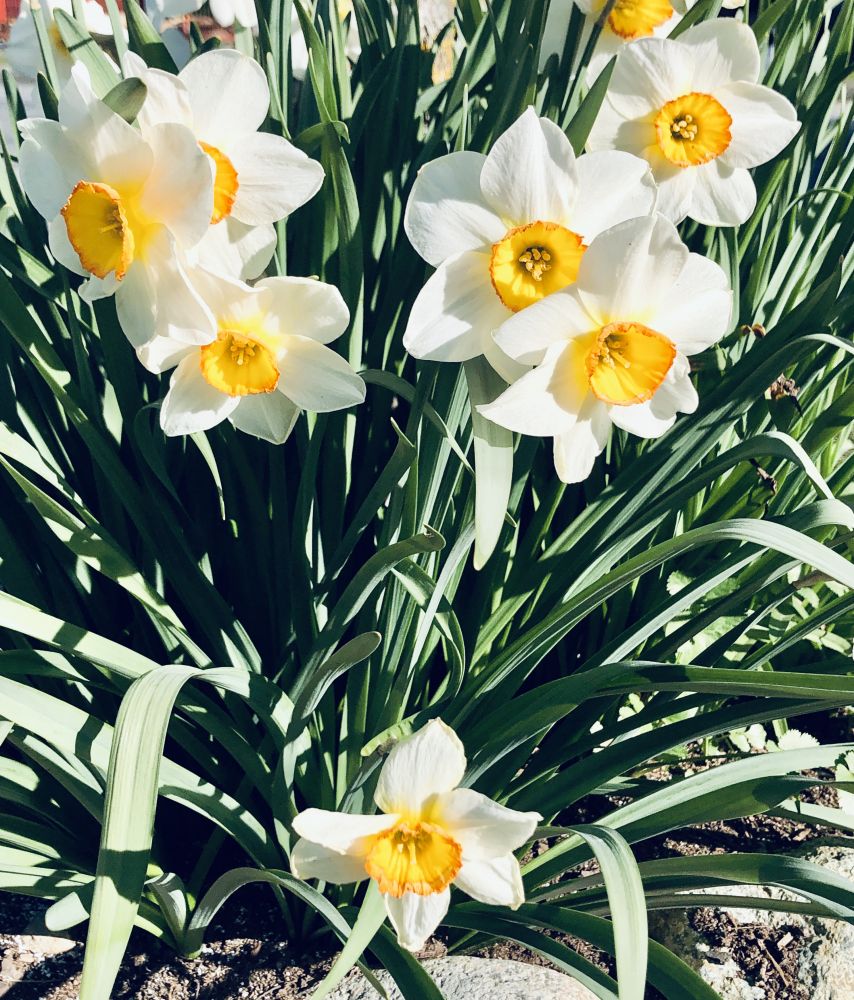 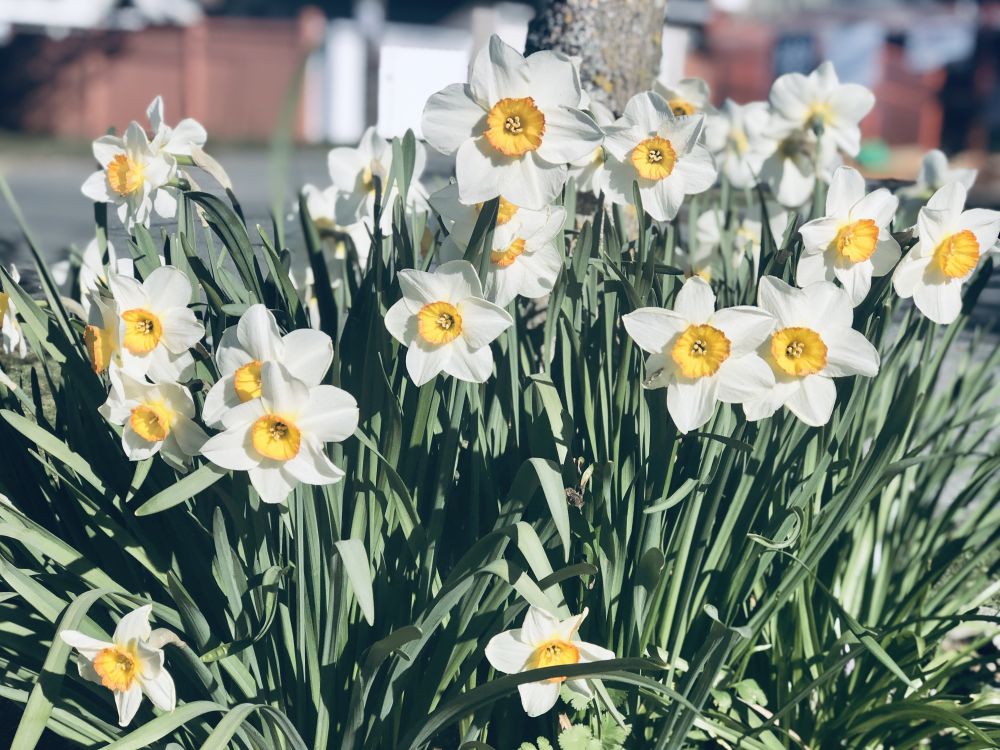
(红口水仙)
维吉尔擅长在描写古罗马田园风光和乡土劳动的同时穿插许多精彩的神话传说,行文优美,读起来如痴如醉。
维吉尔的另一部诗集《牧歌》(Eclogues)也三次提到了水仙花,如下:
第二卷:
“到这儿来吧,俊美的孩子;看吧,仙女们为你带来了一整个篮子的百合花; 为你,美丽的水泉仙女采来浅色的紫香堇和罂粟头,把水仙花和芬芳的茴香花放在一起,用蜡叶芫花和其它香草将它们缠绕,然后把柔软的风信子和金色的万寿菊放在一起。我要亲自采集有着灰白色柔毛的榲桲和阿玛瑞莉丝曾经钟爱的栗子。还有蜡李,让它也享受荣耀。你,哦,月桂,我也要采来,还有你,月桂的邻居香桃木,把你们混在一起香气更加迷人”。
(注:蜡李,即Prunus domestica var. cerea,是古罗马时期的一种嫁接李,果实比较小,但味道不错。)
(Come hither, lovely boy! See, for you the Nymphs bring lilies in heaped-up baskets; for you the fair Naiad, plucking pale violets and poppy heads, blends narcissus and sweet-scented fennel flower; then, twining them with cassia and other sweet herbs, sets off the delicate hyacinth with the golden marigold. My own hands will gather quinces, pale with tender down, and chestnuts, which my Amaryllis loved. Waxen plums I will add – this fruit, too, shall have its honour. You too, O laurels, I will pluck, and you, their neighbour myrtle, for so placed you blend sweet fragrance.)
第五卷:
“通常在我们播撒大麦种子的地方, 无情的毒麦和不育的燕麦疯长。看不见柔嫩的紫香堇,看不见耀眼的水仙花,只有蓟草和荆棘挺直着身板”。
(Often in the furrows, to which we entrusted the big barley grains, luckless darnel springs up and barren oat straws. Instead of the soft violet, instead of the gleaming narcissus, the thistle rises up and the sharp-spiked thorn. )
第八卷:
“那么就让狼从羊群前面逃开吧,让强壮的橡树上挂着金色的苹果,让水仙花在赤杨上绽放, 让怪柳的树皮上渗透出浓厚的琥珀, 让猫头鹰与天鹅相媲美,让提屠鲁斯(希腊传说中的怪兽)成为奥菲厄斯(希腊神话中传奇的音乐家、诗人和先知)- 成为林子里的奥菲厄斯,或海豚群里的阿里昂(希腊神话中的不朽骏马)。 从我开始吧,我的笛子,奏起那迈那鲁(注:古希腊的一个小镇)的歌谣”。
(Now let the wolf even flee before the sheep, let rugged oaks bear golden apples, let alders bloom with daffodils, let tamarisks distil rich amber from their bark, let owls, too, vie with swans, let Tityrus be an Orpheus – an Orpheus in the woods, an Arion among the dolphins!Begin with me, my flute, a song of Maenalus!)
我在阅读的过程中,发现《牧歌》第五卷对水仙花的叙述有两种英文译本。第一种版本的诗句是“instead of gleaming narcissus”,用“gleaming”(耀眼)来形容水仙花洁白的花瓣,而另一个版本则是“in lieu of the empurpled narcissus”,表明水仙花是紫色(empurpled)的。
稍微有一点常识的人都知道世界上没有紫色的水仙花,是不是维吉尔写错了呢?可是如果你参考老普林尼(公元23年-79年)的著作《自然史》(Natural History)第21卷第75章的水仙篇,他分明写到:“有两种水仙在医学中使用,一种带有紫色的花,另一种是草本水仙。”( Two varieties of the narcissus are employed in medicine, the one with a purple flower, and the herbaceous narcissus.)维吉尔与老普林尼的生活轨迹只相差几十年,况且老普林尼是博物学家,他总不会也搞错了吧?
这到底是怎么一回事呢?英国近代著名学者约翰·萨格恩特 (John Sargeaunt , 1857–1922)在他的研究著作《维吉尔的树、灌木和植物》(The Trees, Shrubs and Plants of Virgil,1920年出版)做了解释。现将部分原文翻译如下:
“颜色感,尤其是红和蓝的色感似乎在人类历史上发展得相当晚。除了没有确切的词汇来形容毛茛(buttercup)花瓣的闪亮的黄色,当时的人们对黄色调还是有比较明确的认知的。番红花黄(注:拉丁语croceus,意为saffron yellow)有两种颜色,来自番红花柱头的颜色(注:尖端偏红色或暗红色,而下部是黄色)。草木樨黄(注:拉丁语luteus或luteolus,类似于今天的柠檬黄)来自于用黄花木犀草(注:Weld,学名Reseda luteola)制成的染料。无论是番红花黄还是木犀草黄,都带着一点橙色调。但维吉尔在某处诗文里把两种颜色合二为一,说成saffron weld (番红花木犀草黄)。 Luteum 一词用来形容蛋黄的颜色, flavus(注:拉丁语,即金黄色) 一词通常用来形容成熟的玉米田,有时也形容黄沙,赤褐色的头发和金子。即使我们认为金子是“红金色”(red gold)的,金子也被形容为黄褐色的(fulvum)。其实fulvum的色调更像是狮子身上的黄褐色毛皮,或者稍浅一点的红色狼皮。 gilvus,是浅褐色,用来形容马匹。”
(The colour sense, especially in reds and blues, seems to have developed rather late in man's history. The yellows are fairly clear, except that there seems to be no word which clearly indicates the shining yellow of the buttercup. Both croceus, which comes from the stigmata of the saffron crocus, and luteus or luteolus, which come from the dye of weld, seem to have a dash of orange in them. Virgil in one place combines them and speaks of saffron weld. The yolk of an egg was always called luteum. Then comes flavus, which is used most of fields of ripe corn, but also of the yellow sands, an auburn head of hair, and gold. Gold is also called fulvum, much as we speak of red gold ; for of this hue is the tawny hide of the lion, and even the less red hide of the wolf. Last is gilvus, which is dun, and is used of a horse.)
 
(番红花黄)
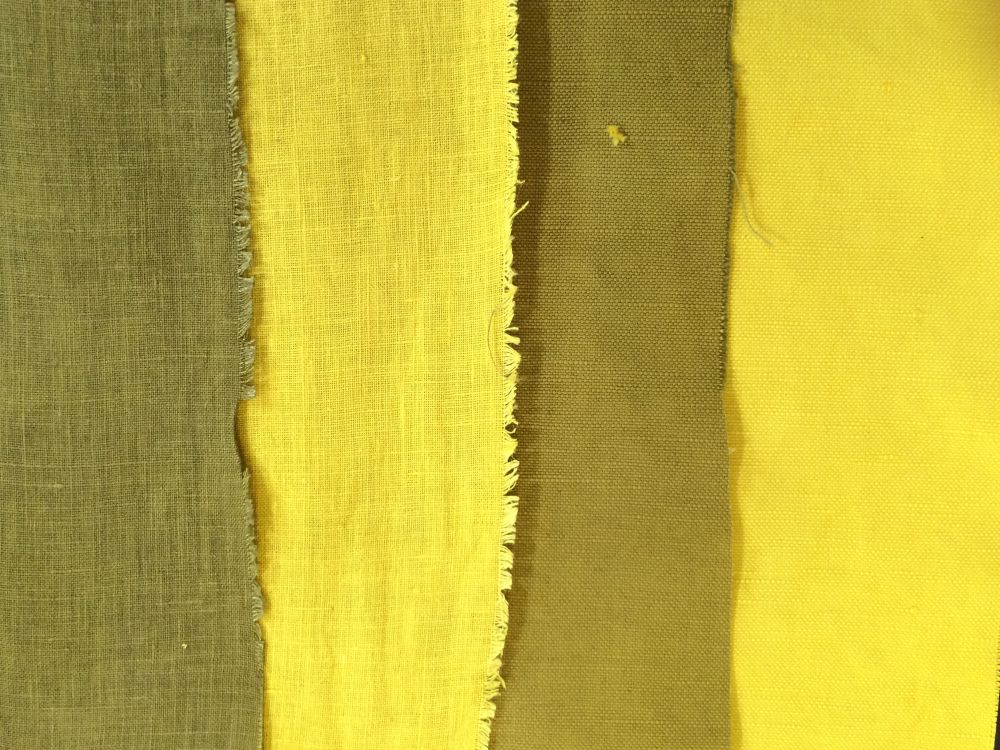
(草木樨黄)
 (flavus, 金黄色) (flavus, 金黄色)
 (fulvum,黄褐色) (fulvum,黄褐色)
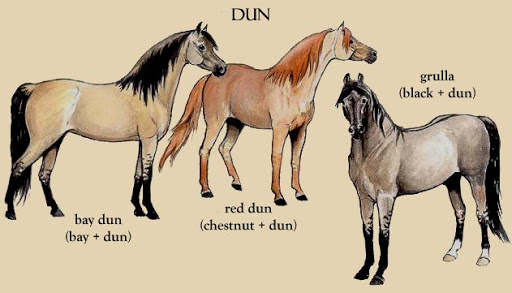
(gilvus, 浅褐色,专门用来形容马匹)
“然后是白色和黑色。很明显的,维吉尔搞不清“Candidus”(注:拉丁语,白花花的意思)与“albus“(注:拉丁语,白色)的区别,用这两个词来形容同一个物体。“Candidus”的原意是‘白热’,指‘耀眼闪光的白色’,但维吉尔用这个词来形容胡须和白杨树的颜色。除非用于隐喻,他也无法区分ater(注:拉丁语,暗黑、黑乎乎的意思)和niger(注:拉丁语,亮黑的意思),确切的说,ater是木炭的颜色。他还把黑白两色的概念伸展应用。比如他形容两个西西里人,他说一个是黑人,另一个是白人。一朵黑色的花的颜色未必比紫色更暗。在某些情况下,他的白即‘颜色没那么黑’,黑即‘色彩没那么白’”。
(Then there are white and black. It seems clear that Virgil does not distinguish candidus and albus, for he applies them both to the same objects. The original meaning of candidus was white hot, and it therefore implies a shining white, but Virgil applies it to a beard and a poplar-tree. Nor can it be made out that he distinguishes ater and niger except in metaphorical uses. Properly ater seems to be the colour of charcoal. There is also a wide extension both of black and of white. Of two Sicilians one is called black and the other white. A black flower need be no darker than violet, and we may say that in some contexts white means little more than not black and black little more than not white.)
“最糟糕的是‘purpureas’(注:拉丁语,紫色)和‘ferrugineus’(注:拉丁语,锈红色)这两个词的用法。用来形容花草时,前者的意思是色彩不那么明亮。这和用来形容年轻人自身光彩的‘lumen iuventae’如出一辙(注:lumen,拉丁语,形容透过窗子的光线, iuventae,拉丁语,指年轻人)。与维吉尔同时代的人用这个词来形容雪色。我没有发现维吉尔用过暗色调,即使他在形容一个人遭遇暴力死亡而魂飞魄散的情形,也没有用暗色调的词汇。另一方面,‘ferrugineus’一词最初是用来形容铁锈的颜色,确实蕴含着暗色调的,维吉尔却用这个词来形容泰利安紫(Tyrian purple,即帝王紫)。他也用这个词来形容因日全食引起的黑暗和卡戎的船只颜色。(注:卡戎是希腊神话中冥河的船夫,负责将死者渡过冥河)。普劳图斯(注:古罗马剧作家,约前254年-前184年,)作品中的一个角色告诉我们ferrugineus也是海的颜色,因为海水会显现诸多颜色,他的说法也没错。看来罗马人可能将这个单词用来形容含有暗红色调的颜色。当维吉尔写风信子时,用“ferrugineos Hyacinthos”来形容,我们不能将红色调从花色中排除。 ”
(Worst of all are the two words purpureas and ferrugineus. As applied to flowers, the former appears to mean no more than bright, a meaning which it retains when applied to the light of youth — ' lumen iuventae.' A contemporary of Virgil applied the epithet to snow, and I cannot see that Virgil ever uses it of a dark hue, not even when he applies it to the breath or soul leaving the body in a violent death. On the other hand, ferrugineus, which must originally have signified the colour of iron rust, does connote some darkness, and clearly Virgil uses it of Tyrian purple. He also uses it of the darkness that comes over the sun in an eclipse and of Charon's boat. A character in Plautus tells us that it is the colour of the sea, and as the sea displays so many colours he was doubtless in part right. It seems, however, that none of these uses would make it impossible for a Roman to apply the word to some shade of red. On the hyacinthus we cannot rule reds out on the ground that Virgil writes of ' ferrugineos hyacinthos.' )
“另一个困难在于我们并不总是确定维吉尔的称谓是指整朵花或着花朵的一部分,是单指植物的花,还是也包含了植株的一部分,如叶子等。对于拉丁人来说,罂粟最重要的部分是种子,因为种子很小,所以维吉尔写成‘小罂粟’,尽管整棵植株会长得比一个男子还高。再次,正如我们在泰奧弗拉斯托斯(Theophrastus,古希腊哲学家和科学家,约公元前371年-公元前287年)的著作中读到的,花的雄蕊和雌蕊够大时,就视为花中的第二朵花。古希腊人就是这样来描述百合与玫瑰的。因此,当维吉尔写‘purpureo narcisso' (紫色的水仙花),在我看来,他是指白色闪亮的外花被;但某些人认为他似乎在说水仙花的杯状物(注:副冠),阿坎盖利称之为‘猩红色的’,尼科尔森的说法更确切一些,认为那是‘猩红色的边缘’”。
(Another difficulty is that we are not always sure whether Virgil's epithet applies to the whole of a blossom or part of it, whether to the blossom at all or to the leaves or some other part. Sometimes we can see him using an epithet as we should not. Thus to a Latin the important part of a poppy is the seeds, and, because the seeds are small, Virgil writes of the small poppy, though the plant will out-top a man. Again, as we see in Theophrastus, when the stamens and pistils of a flower were large they were regarded as a second flower within the other. The Greek writes thus, for instance, of the lily and the rose. Thus when Virgil writes ‘ purpureo narcisso ' he seems to me to refer to the shining white of the outer perianth ; but to some he seems to speak of the cup, which Arcangeli calls scarlet, and Nicholson, perhaps more correctly, scarlet-edged.)
我并非学美术出身,也是植物学的门外汉,但我从专家学者的考证中得出了这样的结论:几千年前人类眼中的色彩远不如当今世界丰富,人们对色彩的认知是一个渐进的过程。随着20世纪初便宜的合成染料推向市场,我们眼中的色彩越来越丰富,科学知识的发展也使今人对植物和色彩的描述有了一定的科学规范性。我们翻译古典作品时,不可能期望古人拥有相同的认知,必须基于当时的历史环境和文明程度,对他们的描述作出正确的判断,而不是简单地以为古人犯了常识性错误。维吉尔在《牧歌》里写的应该是红口水仙,浅杯状的副冠边缘有橙红或深红色的皱褶。维吉尔用“purpureo”一词来形容“杯口”的深色调。
同样的道理,《荷马诗颂》里的那句“还有水仙花,宽广的大地使它长成番红花那样的黄色”(and the narcissus which the wide earth caused to grow yellow as a crocus),说的不是黄水仙和黄色番红花。我在前文中已经提到过了,诗歌中的水仙指的是花瓣洁白的多花水仙。地中海和西亚一带的野生番红花大多拥有浅蓝、紫蓝色、深紫色的花瓣,偶有白色和黄色花瓣品种。古希腊和罗马作家笔下的黄色番红花指的是硕大的橙黄色花柱,在他们眼里,雄蕊(或雌蕊)够大,就是花中的第二朵花,故所有的番红花都是黄色的。多花水仙的浅杯状副冠是橙黄色或黄色的,很引人注目,也算是“花中花”,故水仙花也是黄色的,与番红花的花柱颜色相似。
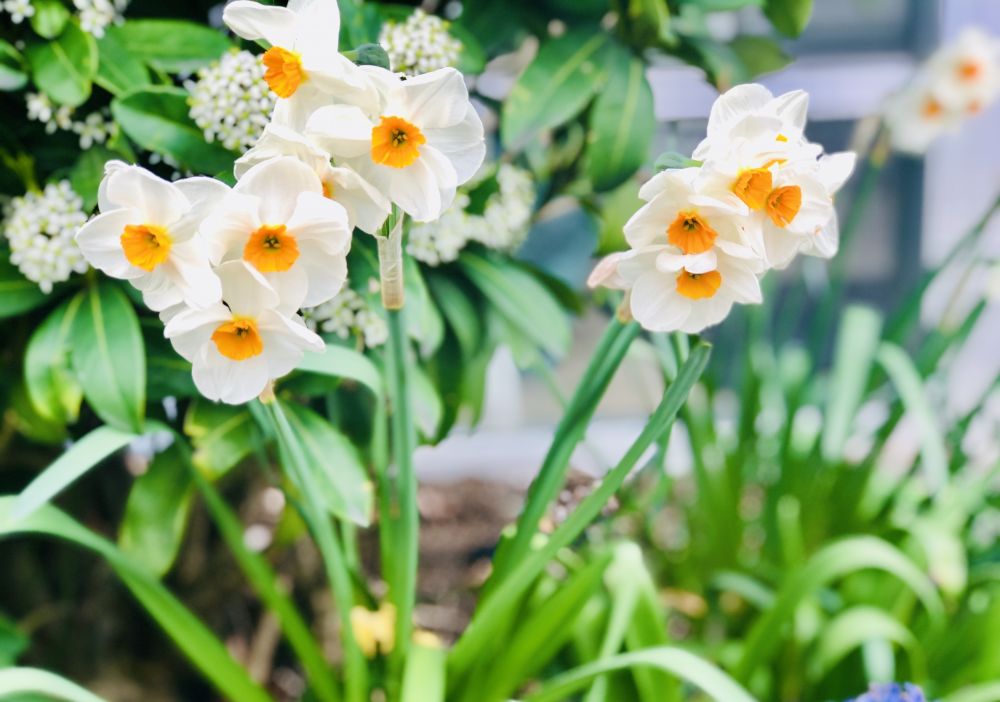
(多花水仙)
 
 (番红花) (番红花)
|